
Panini: His Work And its Traditions (Volume One - Background and Introduction)
Book Specification
| Item Code: | IDE769 |
| Author: | George Cardona |
| Publisher: | MOTILAL BANARSIDASS PUBLISHERS PVT. LTD. |
| Language: | English |
| Edition: | 1997 |
| ISBN: | 9788120804197 |
| Pages: | 827 |
| Cover: | Hardcover |
| Other Details | 9.8" X 6.8" |
| Weight | 1.60 kg |
Book Description
From the Jacket:
This is the first volume of a study of Panini's work, its antecedents, and the traditions of interpretation and analysis to which it gave rise. This revised second edition includes the text of Panini's Astadhyayi with indications of changes that were introduced to this text and a discussion concerning such changes. Subsequent volumes take up in full detail issues of interpretation, method, and theory associated with the Astadhyayi. This first volume is meant to provide a basis for such detailed discussions. To this end, the author describes briefly the structure of the Astadhyayi with its ancillaries, outlines Panini's derivational system, and considers in general the principles that guided Panini in composing his grammar in the way he did as well as the grounds on which he arrived at the particular basic forms with which he operates in his derivational system.
About the Author:
George Cardona was born in New York City in 1936. He received a doctorate in Linguistics, specializing in comparative Indo-European, from Yale University in 1960. In India, he studied Paninian grammatical works and texts in other sastras with Jagannath S. Pade Shastri, Ambika Prasad Upadhyaya, K.S. Krishnamurti Shastri and Raghunatha Sharma. Since 1960 he has taught at the University of Pennsylvania, where he is Professor of Linguistics. In addition, he has taught at several other universities as a visiting professor. He was a fellow of the Center for Advanced Studies in the Behavioural Sciences, Palo Alto, in 1971-1972, and was Collitz Professor at the summer institute of the Linguistic Society of America at University of Illinois in 1978. He is a past president of the American Oriental Society (1989-90) and a member of the American Academy of Arts and Sciences.
Excerpts From Reviews:
'Cardona deserves our thanks for the labour involved in producing such a clean text to reproduce. The subject matter, though, is more important than the form and here, while any complete assessment must await the remainder of this major undertaking, it is already clear that Cardona is placing us all in his debt once again by the range and comprehensiveness of his scholarship in Paninian studies, as well as by the clarity of his exposition. - J.L. BROCKINGTON, Journal of the Royal Asiatic Society, 1990, p.183
'By way of a final remark, it must be said that all co-students in the field would, with one voice and equally heartily, congratulate Professor Cardona over the tremendous spent on the book and over the remarkable success it has attained. Subsequent volumes in the projected series are eagerly awaited.' - S.D. LADDU, Annals of the Bhandarkar Oriental Research Institute, LXX (1989), p. 353
'Vol. 1 is a superb introduction to Panini, the best ever in English. To aid the foresight of rsis who wish to predict the effects and importance of the volumes yet to come, Cardona has sprinkled numerous cross-references to all seven. Every hour spent with Vol. 1 increases our impatience to see this ambitious work completed.' - W.G. REGIER and R.E. WALLACE, Language 67(1991), p. 166
| Introduction to the first edition | v-viii | ||
| Introduction to the second edition | ix-xii | ||
| Some disagreements | xiii-xxxix | ||
| References and abbreviations | xlv-l | ||
| On cross references and notation | li-lxiv | ||
| 1. | Panini's Work (1-211) | 1-135 | |
| 1.0 | Introduction (1-8) | 1-4 | |
| 1.1 | Panini's sutrapatha: the Astadhyayi (9-127) | 4-79 | |
| 1.1.0 | Introduction (9-13) | 4-7 | |
| 1.1.1 | Operational rules (14-26) | 7-13 | |
| 1.1.1.1 | Affixation rules (15-16) | 7-8 | |
| 1.1.1.2 | Augments (17-19) | 8-10 | |
| 1.1.1.3 | Substitution rules (20-22) | 10 | |
| 1.1.1.4 | Rules providing for a single remainder (23) | 11-12 | |
| 1.1.1.5 | Rules for doubling elements (24-25) | 12 | |
| 1.1.1.6 | Composition rules (27-117) | 13-74 | |
| 1.1.2 | Ancillary rules (27-117) | 13-74 | |
| 1.1.2.1 | Samjnasutras (28-88) | 13-52 | |
| 1.1.2.1.1 | Samjnasutras that establish general conventions (28-31) | 13-15 | |
| 1.1.2.1.2 | Samjnasutras that introduce class names (32-88) | 15-52 | |
| 1.1.2.1.2a | Phonological classes (33-44) | 16-20 | |
| 1.1.2.1.2b | Classes of grammatical elements (45-75) | 20-43 | |
| 1.1.2.1.2c | The pragrghya class (76) | 43-44 | |
| 1.1.2.1.2d | Classes whose members are not linguistic units (77-78) | 44-45 | |
| 1.1.2.1.2e | Terms for zero (79) | 46-47 | |
| 1.1.2.1.2f | Markers and abbreviatory terms (80-88) | 47-52 | |
| 1.1.2.2 | Metarules (89-104) | 52-64 | |
| 1.1.2.3 | Headings (105-117) | 64-74 | |
| 1.1.3 | Restrictive and negative rules (118-119) | 74 | |
| 1.1.4 | Examples showing how sutras are interpreted (120-127) | 75-79 | |
| 1.2 | Panini's aksarasamamnaya (128-131) [List of Pratyaharas: 129] | 80-84 | |
| 1.3 | Panini's dhatupatha (132-201) | 85-129 | |
| 1.3.0 | Introduction (132-133) | 85-86 | |
| 1.3.1 | Shapes of verbs and metalinguistic features (134-154) | 86-99 | |
| 1.3.2 | Groups and subgroups of verbs in thedhatupatha (155-182) | 100-120 | |
| 1.3.3 | Sutras in the dhatupatha (183-201) | 120-129 | |
| 1.4 | Panini's ganapatha (202-211) | 130-131 | |
| 1.4.1 | Exhaustive listings and type listings (204) | 131-132 | |
| 1.4.2 | Groups and subgroups in the ganapatha (205) | 132 | |
| 1.4.3 | Sutras in the ganapatha (206-207) | 133-135 | |
| 2. | Panini's derivational system (212-622) | 136-400 | |
| 2.0 | Introduction (212-228) | 136-400 | |
| 2.1 | Simple sentences (229-255) | 144-167 | |
| 2.2 | Complex sentences (256-268) | 167-178 | |
| 2.3 | Agreement phenomena and femininie affixes (269-276) | 178-185 | |
| 2.4 | Derived bases (277-369) | 186-255 | |
| 2.4.0 | Introduction (277) | 186 | |
| 2.4.1 | Derived verbal bases (278-281) | 186-188 | |
| 2.4.1.1 | Deverbatives (279-281) | 186-188 | |
| 2.4.1.2 | Denominatives (283) | 188-189 | |
| 2.4.1.3 | Special rules for derived verbs (284-286) | 190-192 | |
| 2.4.2 | Derived nominal bases (289-368) | 192-255 | |
| 2.4.2.1 | Derivates with Krt affixes (289-298) | 192-203 | |
| 2.4.2.2 | Subordination and time references of derivates (299-300) | 204-205 | |
| 2.4.2.3 | Compounds (301-329) | 205-229 | |
| 2.4.2.3.0 | Introduction (301-303) | 205-208 | |
| 2.4.2.3.1 | Avyayibhava compounds (304-307) | 208-212 | |
| 2.4.2.3.2 | Tatpurusa compounds (308-307) | 208-212 | |
| 2.4.2.3.3 | Bahuvrihi compounds (317) | 219-221 | |
| 2.4.2.3.4 | Dvandva compounds (318) | 221 | |
| 2.4.2.3.5 | Upasarjanas and the order of constituents (319-322) | 221-224 | |
| 2.4.2.3.6 | Deletion and retention of endings in compounds (323) | 224-225 | |
| 2.4.2.3.7 | Special number rules for compounds (324-325) | 225-227 | |
| 2.4.2.3.8 | Gender rules for compounds (326-329) | 227-229 | |
| 2.4.2.4 | Taddhita affixes (330-368) | 229-255 | |
| 2.4.2.4.0 | Introduction (330) | 229 | |
| 2.4.2.4.1 | Affixes introduced optionally (331-353) | 229-247 | |
| 2.4.2.4.2 | Other taddhita affixes (354-367) | 247-255 | |
| 2.4.2.4.3 | Retention of endings in taddhita derivatives (368) | 255 | |
| 2.4.2.4.4 | Gender marking (369) | 256 | |
| 2.5 | Syntactic doubling (370-372) | 257-259 | |
| 2.6 | Ekasesa (single remainder) (373-377) | 260-262 | |
| 2.7 | Rules of replacement, artial doubling, and augmenting (378-585) | 263-375 | |
| 2.7.0 | Introduction (378) | 263 | |
| 2.7.1 | Grammatical elements (379-521) | 263-338 | |
| 2.7.1.1 | Verb suppletion (379-521) | 263-265 | |
| 2.7.1.2 | Partial doubling, oerations on abhyasa syllables (382-387) | 266-269 | |
| 2.7.1.3 | Other operations on verbs and verbal affixes (388-458) | 269-305 | |
| 2.7.1.3.1 | Rules outside the section headed by A 6.4.1 (388-410) | 269-281 | |
| 2.7.1.3.2 | rules headed by A 6.4.1 (411-444) | 282-296 | |
| 2.7.1.3.3 | Rules headed by A 6.4.22 (445-458) | 297-305 | |
| 2.7.1.4 | Operations on nominal bases, stems and endings (459-506) | 305-329 | |
| 2.7.1.4.1 | Rules outside the section headed by A 6.4.1 (459-467) | 305-309 | |
| 2.7.1.4.2 | Rules headed by A 6.4.1 (468-499) | 309-325 | |
| 2.7.1.4.3 | Rules headed by A 6.4.22 (500-506) | 325-329 | |
| 2.7.1.5 | Replacement of entire padas (507-508) | 329-330 | |
| 2.7.1.6 | Replacement of cover symbols (509-510) | 330-332 | |
| 2.7.1.7 | Imposition of markings (511-521) | 332-338 | |
| 2.7.2 | Other sound replacements and augments (522-585) | 339-346 | |
| 2.7.2.1 | Rules outside the tripadi (522-537) | 339-346 | |
| 2.7.2.1.1 | Rules outside the section headed by A 6.1.72 (522-523) | 339 | |
| 2.7.2.1.2 | Rules of the section headed by A 6.1.72 (524-537) | 339-346 | |
| 2.7.2.2 | Rules in the tripadi (538-585) | 346-375 | |
| 2.8 | Accentual rules (586-622) | 376-378 | |
| 2.8.0 | Introduction (586-591) | 376-378 | |
| 2.8.1 | Accents of bases, affixes, and individual padas (592-613) | 378-392 | |
| 2.8.2 | Accents of connected padas (614-622) | 392-400 | |
| 3. | General principles observed in the grammar (623-665) | 404-427 | |
| 3.0 | Introduction (623-629) | 401-404 | |
| 3.1 | General rules and exceptions (630-642) | 404-412 | |
| 3.2 | Internally and externally conditioned operations (643-648) | 412-417 | |
| 3.3 | Nitya and anitya operations (649-652) | 417-419 | |
| 3.4 | Suspension of rules and their effects (653-661) | 419-425 | |
| 3.5 | Application of rules in the order they are stated (662-665) | 425-427 | |
| 4. | The background of Panini's system (666-825) | 428-542 | |
| 4.0 | Introduction (666) | 428 | |
| 4.1 | Analysis leading to the extraction of elements (667-696) | 428-449 | |
| 4.1.1 | Analysis: reasoning from anvaya and vyatireka (667-669) | 428-431 | |
| 4.1.2 | Positing zero replacements (670-676) | 431-437 | |
| 4.1.3 | Signifiers, cosignifiers, and affixes with no meaning (677-688) | 437-443 | |
| 4.1.4 | Positing augments (689-696) | 443-449 | |
| 4.2 | Basic forms posited in the grammar (697-825) | 449-542 | |
| 4.2.0 | Introduction (697-698) | 449-450 | |
| 4.2.1 | Basic forms and phonologically conditioned variants (699-710) | 450-459 | |
| 4.2.2 | Basic nominal endings (711-726) | 459-475 | |
| 4.2.3 | Basic verb endings (727-753) | 475-498 | |
| 4.2.3.0 | Introduction (727) | 475-476 | |
| 4.2.3.1 | Endings in different tense and modal forms (728-743) | 476-486 | |
| 4.2.3.2 | The set of basic verb endings (744-753) | 487-498 | |
| 4.2.4 | Basic forms of nominal bases (754-787) | 498-516 | |
| 4.2.5 | Basic forms of verbs (788-825) | 516-542 | |
| Appendices | 543-731 | ||
| I. | The Status and purposes of grammar (826-837) | 543-556 | |
| II. | Terms for the language described and for the grammar and its components (838-853) | 557-576 | |
| A. Samskr, Samskrta, Samskara (838-844) | 557-576 | ||
| B. Sabdanusasana, vyakarana, sastra, sutra, yoga, laksana (845-853) | 564-576 | ||
| III. | Astadhyayisutrapatha | 577-731 | |
| Introduction (854-881) | 577-731 | ||
| Devanagari text | 607-674 | ||
| Romanized text | 675-731 | ||
| Index locorum | 733-763 | ||
**Contents and Sample Pages**
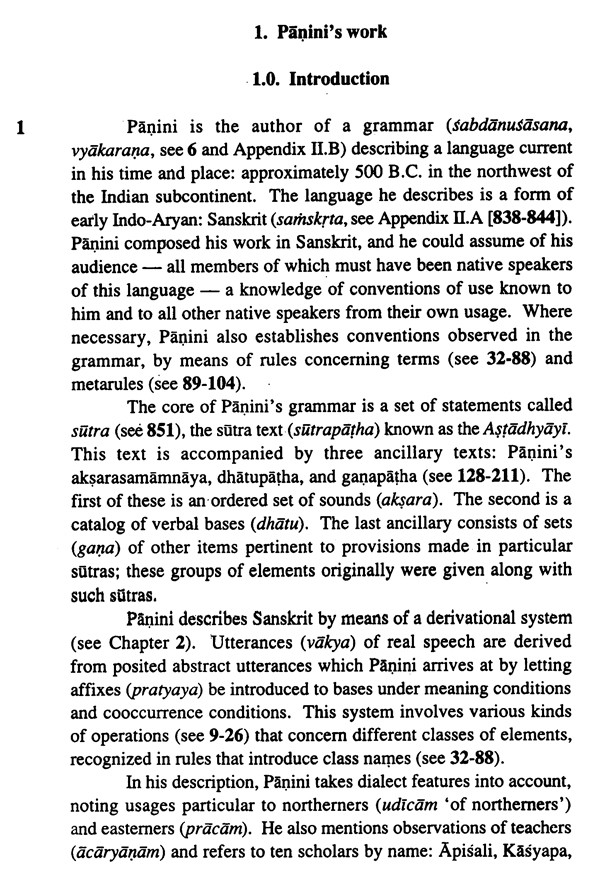
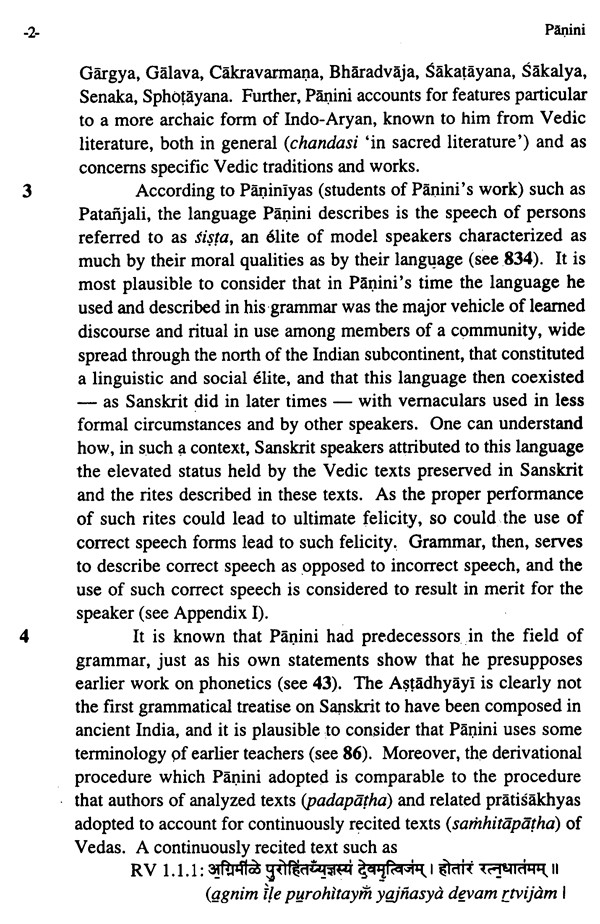
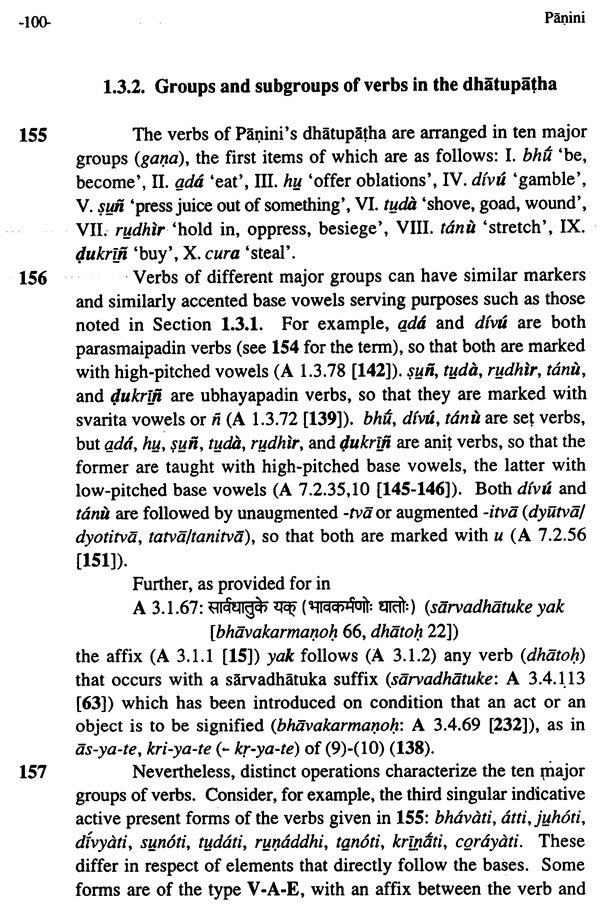
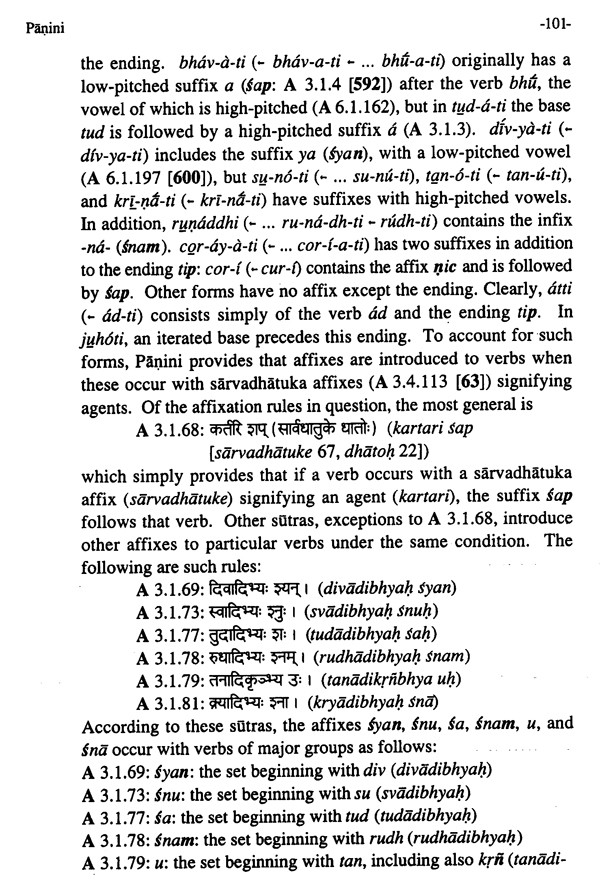
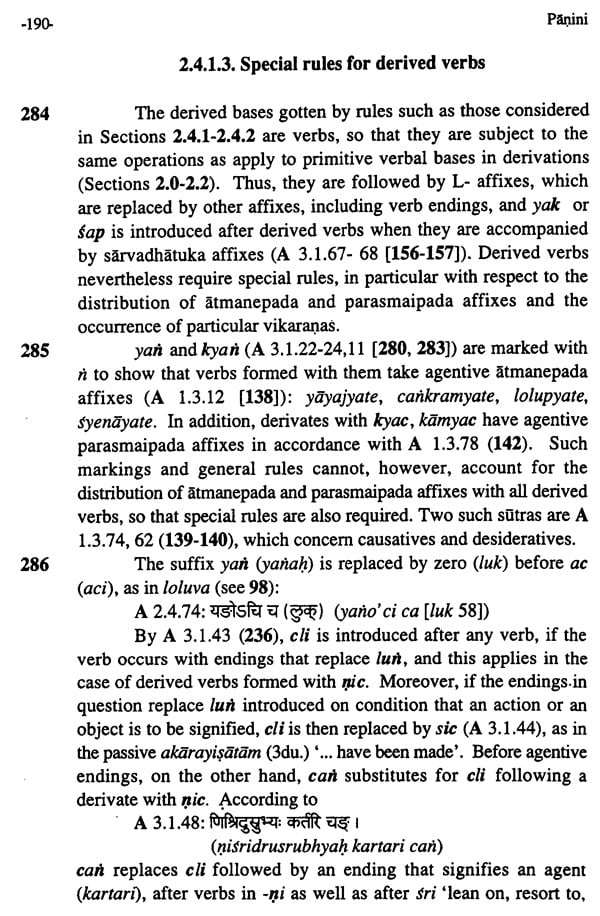
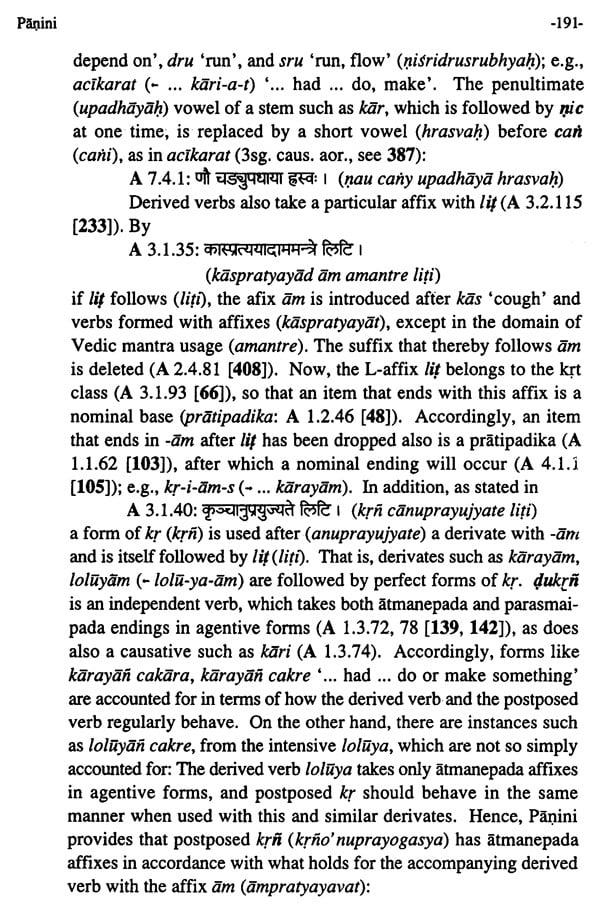
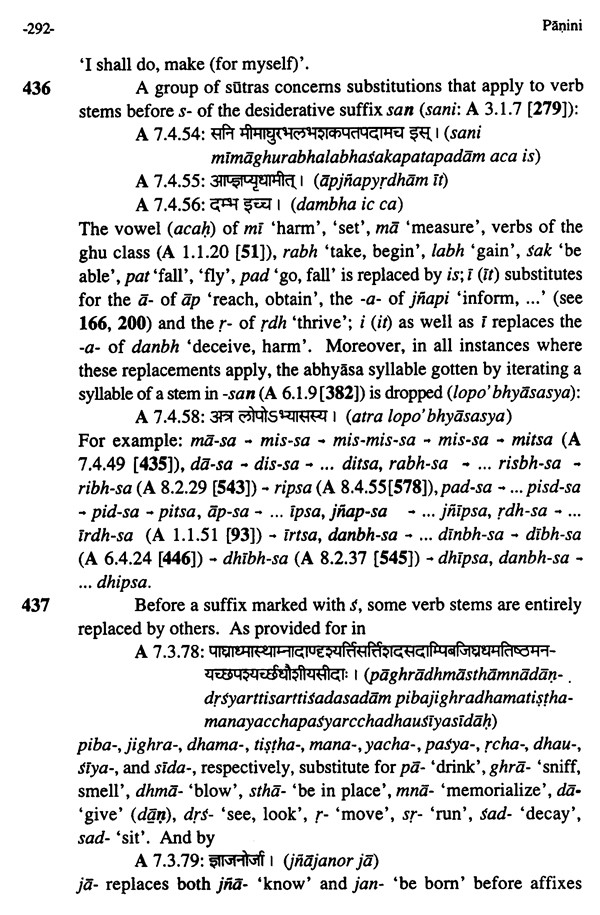


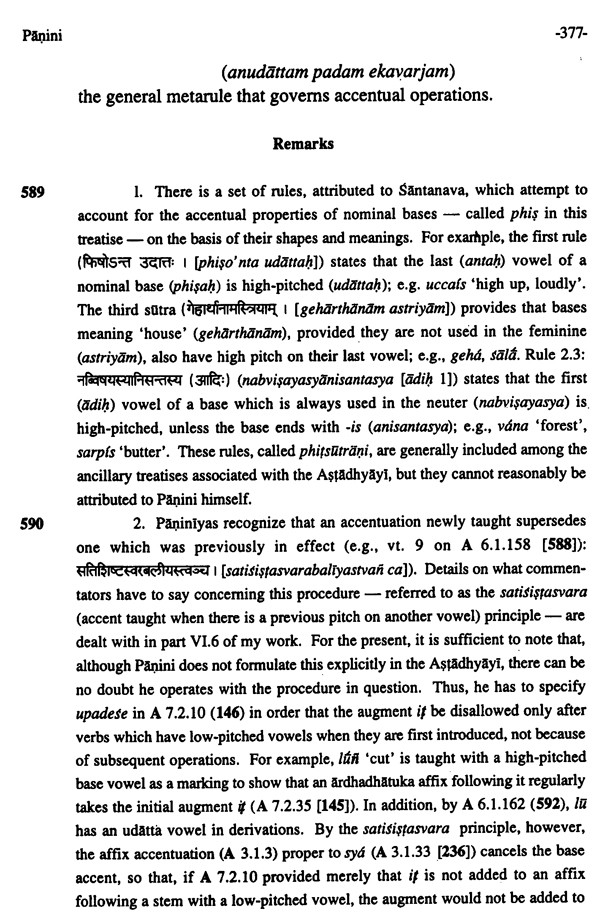
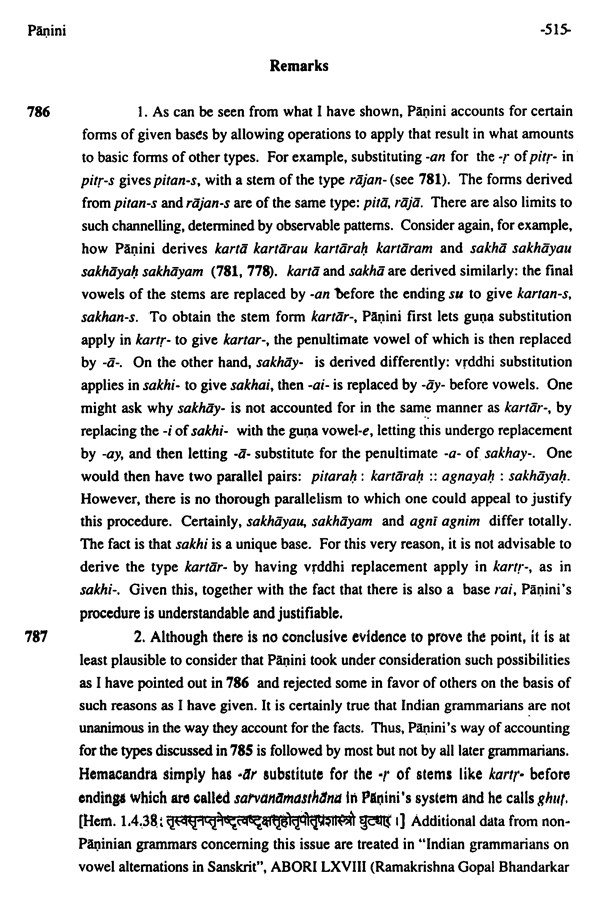

Click Here for More Books Relating to Panini
 to all international destinations within 3 to 5 days, fully insured.
to all international destinations within 3 to 5 days, fully insured.




